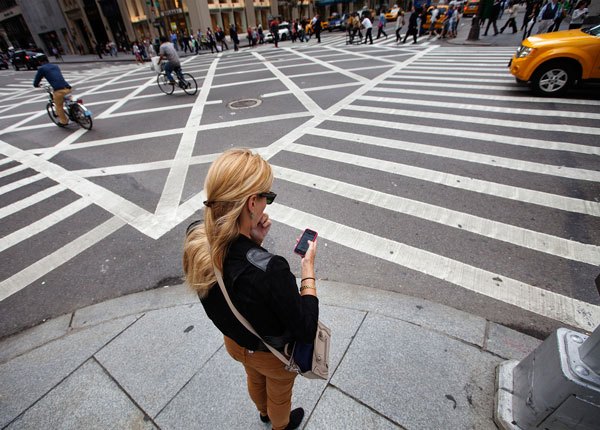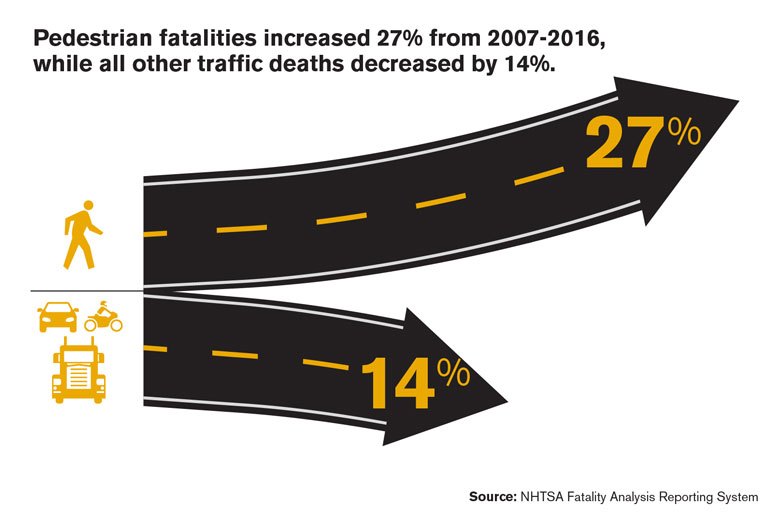
Road Rules for Pedestrians: Crossing, Safety and Right-of-Way
Updated May 5, 2021The word pedestrian refers to any person traveling on foot or with a human-powered conveyance such as a skateboard, or rollerblades. People with disabilities who use powered wheelchairs, tricycles and similar assistive vehicles also qualify as pedestrians. Cyclists are not considered to be pedestrians in most states and are subject to a different set of rules.
When not driving a vehicle, you are also a pedestrian. As pedestrian safety is the responsibility of drivers and pedestrians, you must learn how to protect yourself from harm while walking on or near public roadways. Having the right-of-way at marked and unmarked pedestrian crossings does not mean you are safe. Irresponsible and distracted drivers may not always yield to pedestrians when they should. As a pedestrian, if you are involved in a collision with a car, right-of-way laws will not protect you from death or injury.
Auto-pedestrian accidents and collisions
A Governors Highway Safety Association (GHSA) report released in early 2018 shows what a serious issue pedestrian safety continues to be, despite efforts made to reduce nationwide deaths and injuries. In 2017, almost 6,000 pedestrians were killed in pedestrian-vehicle accidents. This figure is essentially unchanged from the previous year and refers to fatalities only. If pedestrian injuries from car accidents were factored into the report, that number would be many times higher.
From 2007 to 2016 there has been a steady increase in the number of pedestrian deaths each year. This is thought to be a pedestrian safety issue rather than a general traffic issue, as all other road-related deaths have decreased during that period.
 Source: NHTSA Fatality Analysis Reporting System
Source: NHTSA Fatality Analysis Reporting SystemWhile the fact that pedestrian deaths have not increased further between 2016 and 2017 indicates a change for the better, there is still a lot of work to be done to improve pedestrian safety. You can do your part by sticking to the rules and safety guidelines.
Crossing laws and right-of-way
You must observe the following safety rules when seeking to cross the street at a marked or unmarked pedestrian walkway.
- Always wait for pedestrian traffic signals to display WALK or green before attempting to cross the road, where traffic signals are present.
- Do not assume that a green traffic signal means you can cross the road safely. Look right and left to check that all vehicles have come to a stop, as not every driver will obey the rules.
- Do not step out onto a pedestrian crosswalk to force a vehicle to stop. If the driver of that vehicle is unable or unwilling to stop, you could be injured or killed.
- Remain on the curb until it is safe to cross. Vehicles traveling too close to the curb could strike you if you wait on the street itself.
- Always yield to vehicles driving across the intersection when the pedestrian signal reads DON’T WALK or is red.
Safety at intersections without stop signs
Motorists will only stop at intersections not marked with a STOP sign if they see a pedestrian waiting to cross. Make sure that every approaching vehicle has seen you and is slowing to a stop before crossing the intersection; do not assume that all drivers will stop just because one driver has. It takes a few moments for drivers to react to a waiting pedestrian at an intersection, so do not suddenly walk or run into the street. When you cross, do so in a timely fashion without holding up traffic unnecessarily.
Jaywalking
Jaywalking – a term that describes crossing or walking in the street without regard for approaching traffic - is incredibly dangerous, not to mention illegal. You must only seek to cross the road at intersections where the pedestrian has the right-of-way. Crossing the street in the middle of a block between two intersections puts pedestrians at significant risk of injury and in some parts of the United States could also result in a sizable fine.
 Cross only at crosswalks. Jaywalking is illegal. Jaywalking and dashing across intersections could be the end of you. Of every five people killed in a traffic accident, one is a pedestrian.
Cross only at crosswalks. Jaywalking is illegal. Jaywalking and dashing across intersections could be the end of you. Of every five people killed in a traffic accident, one is a pedestrian.Rules for streets without sidewalks
Pedestrians are permitted to walk on some roads without a sidewalk, but they must do so while facing oncoming traffic. You must always stick to the sidewalk when there is one available. In busy residential and business districts, walking on the road for any reason is prohibited.
Toll bridges and highways
Walking on toll bridges and toll highway crossings is also illegal. The only exception to this rule being when there is a sidewalk of more than three feet wide present, which is clearly marked with signs indicating that pedestrians may use it.
Injury prevention safety tips
Ultimately, your safety as a pedestrian is your responsibility. The National Highway Traffic Safety Administration (NHTSA) has issued the following pedestrian safety tips to help you avoid injury while traveling on foot.
- 1

b'Avoid distractions while crossing the street. Electronic devices such as cell phones, tablets and mp3 players can detract your attention from an oncoming threat, such as a driver who has failed to slow down at an intersection. Wearing headphones is particularly dangerous, as you may not hear an approaching vehicle. Pedestrians should also refrain from chatting to people around them and sightseeing while using a crosswalk.'
- 2

b'Wherever possible, avoid walking along a street or highway while intoxicated. This is incredibly dangerous, as your reaction time and ability to see oncoming vehicles may be severely impaired while intoxicated. Should you step out or stumble into the path of a vehicle unexpectedly, the driver of that vehicle may not have enough time to brake to avoid a collision.'
- 3

b'Wear bright or reflective clothing when walking at night. You may also choose to carry a flashlight in areas that are not well-lit. These measures will make you far more visible to drivers, but they will not guarantee your safety.'
- 4

b'Do not assume that a driver approaching a pedestrian crossing has seen you. Always make eye contact with them before stepping out into the street.'
- 5

b'If you must cross the road in an area where no pedestrian crossing is available, find a well-lit area with a clear view of the traffic traveling in both directions. Do not step out into the street behind a parked vehicle that may hide you from oncoming motorists. Wait for a gap in traffic large enough that you can cross safely, continuing to check for cars as you go.'
Other pedestrian laws
In most states, hitchhiking is illegal. Any pedestrian found soliciting a ride from the driver of a private vehicle is committing an infraction and may be subject to a fine. However, in most of the states that prohibit hitchhiking, soliciting a ride in an emergency is permitted. As this exception refers to serious emergencies only and hitchhiking is a dangerous practice, it is best to avoid it at all costs. Keep in mind that penalties and exceptions regarding hitchhiking vary quite dramatically from state to state.
Skiing or tobogganing on roadways is prohibited if it interferes with the flow of traffic. Any person skiing at a walking pace qualifies as a pedestrian and is subject to the same rules and rights.




